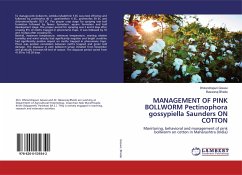To manage pink bollworm, lambda-cyhalothrin 5 EC was most effective and followed by profenofos 40 + cypermethrin 4 EC, profenofos 50 EC and chlorantraniliprole 18.5 SC. The proper crop stage for spraying was boll formation followed by flower formation, square formation and boll development stage. The proper period for spraying was 2 and 6 days after crossing ETL of moths trapped in pheromone traps. It was followed by 10 and 14 days after crossing ETL. Rainfall, maximum temperature, minimum temperature, evening relative humidity and wind velocity had significantly negative and bright sunshine had significantly positive impact on moths trapped in pheromone traps. There was positive correlation between moths trapped and green boll damage. The diapause in pink bollworm larvae initiated from November and gradually increases till end of season. The diapause period varied from 41.95 to 143.20 days.








